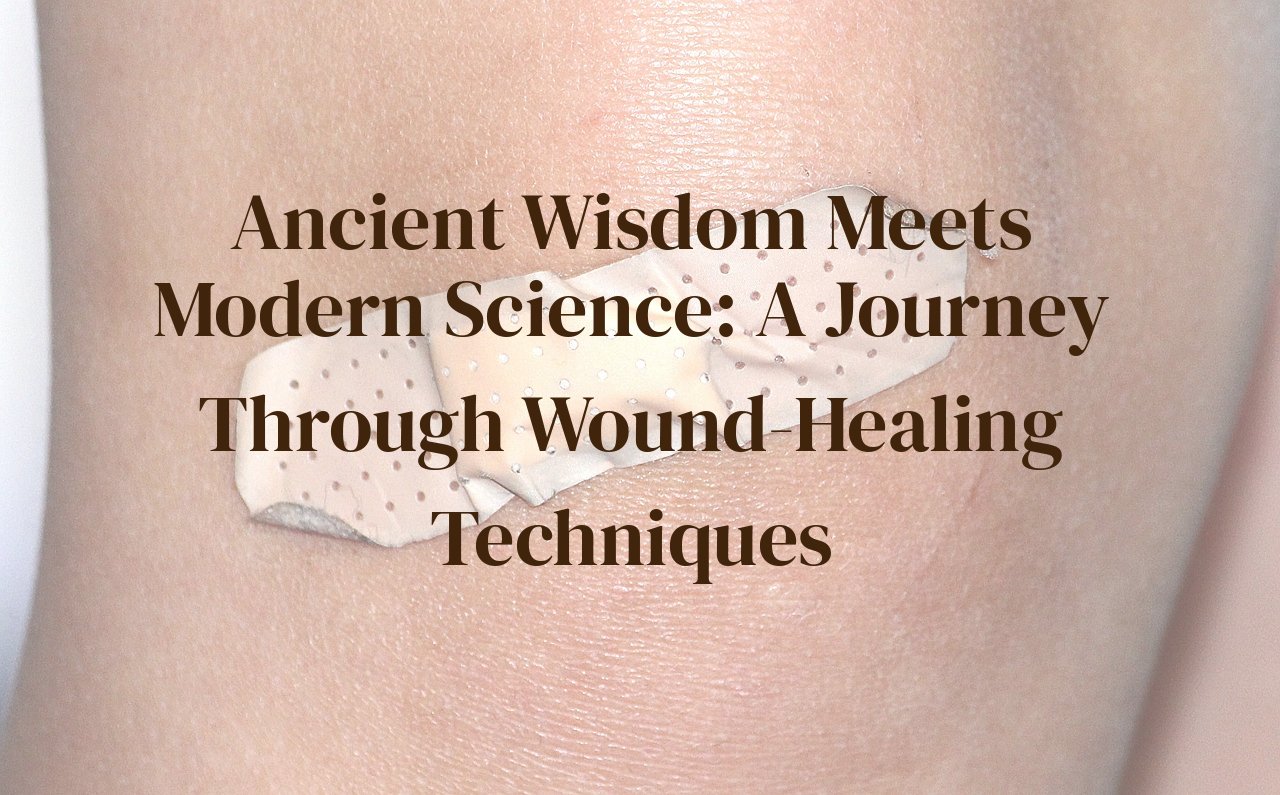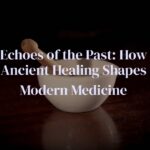
In this post, we dive deep into the fascinating world of wound-healing techniques, blending the old with the new. We will explore the differences and the similarities between traditional wound-healing methods and modern medical techniques.
By reading this post, you will gain insightful knowledge on various wound treatment methods, understand which methods have stood the test of time, and discover how modern advancements are revolutionizing the way we approach wound care. This information can empower you to make informed decisions about wound treatments, whether for yourself or someone you care about.
Table of Contents
The Timeless Knowledge of Traditional Wound-Healing Techniques
Throughout history, human beings have relied on nature to heal wounds, showcasing a treasure trove of traditional techniques passed down through generations. From ancient Egypt to the indigenous tribes of the Amazon, these methods were not only effective for their time but also laid the groundwork for modern practices.
One of the most prominent traditional techniques is the use of honey. Known for its antimicrobial properties, honey has been used for centuries to dress wounds and prevent infection. Ancient Egyptians documented its usage in the Edwin Smith Papyrus, making it one of the oldest known medical guidelines.
Another fascinating method is the use of herbs and plants, such as Aloe Vera, which dates back to the Sumerian civilization. The gel extracted from the Aloe Vera plant serves as a soothing anti-inflammatory agent, promoting rapid cell regeneration. Indigenous tribes also harnessed the healing power of plantain leaves, which contain allantoin, a compound known for its cell growth-promoting properties.
In Ayurvedic medicine, traditional wound-healing methods often involve Turmeric, a spice celebrated for its anti-inflammatory and antiseptic attributes. The curcumin in turmeric fights bacterial infections and accelerates the healing process. Copper vessels filled with water were also used, based on the belief that copper has antimicrobial properties that help ward off infections.
Applying animal fats and oils is another technique prominent in ancient cultures, especially among Native Americans. The richness in Omega-3 acids and other nutrients in emu and cod liver oil helps in moisturizing and reconstructing damaged skin barriers.
The art of stitching wounds was mastered long before modern surgical methods, with ancient civilizations like the Greeks using catgut sutures, derived from the intestines of sheep or goats, for their natural absorbable properties.
Each of these traditional methods carries with it a story rich in cultural and experiential knowledge, often as effective psychically as they were physically. Growing up, I often saw my grandmother reach for a jar of honey or a freshly cut leaf of Aloe Vera from her garden whenever I scraped my knees. The comfort and care enveloped in these traditional methods resonate deeply, forming a seamless blend of medicine and compassion.
As we delve into the world of traditional wound-healing techniques, it becomes profoundly clear that these age-old methods offer more than just physical relief — they are a connection to our roots, laden with wisdom and the shared human experience of healing.
Scientific Advancements in Modern Wound-Healing Methods
When we delve into the realm of contemporary wound-healing methodologies, the sheer magnitude of scientific progress becomes evident. Modern medicine has taken giant strides to enhance the wound recovery process, making use of novel materials and advanced technologies.
One significant breakthrough in the modern treatment of wounds is the use of bioengineered skin substitutes. These substitutes, often composed of autologous cells or stem cells, offer a viable solution for patients with extensive burns or chronic wounds. By closely mimicking the natural structure and function of the skin, these substitutes provide a fertile ground for new tissue growth, thus accelerating the healing process.
Platelet-rich plasma (PRP) therapy has also gained traction in the medical community. This technique involves drawing a patient’s blood, processing it to concentrate the platelets, and then injecting this platelet-rich plasma into the wound site. The high concentration of growth factors in PRP stimulates cellular repair and regeneration, promoting faster wound healing.
We cannot overlook the advent of nanotechnology in wound care. Nanoparticles, such as silver nanoparticles, are integrated into wound dressings for their potent antimicrobial properties. By targeting and eliminating pathogenic bacteria, these nanomaterials significantly reduce the risk of infection, thus facilitating a more resilient healing environment.
Another groundbreaking innovation is the use of negative pressure wound therapy (NPWT). This method involves placing a special dressing on the wound and applying controlled suction to remove excess exudate and improve blood circulation. My personal experience with NPWT on a patient’s non-healing ulcer revealed its efficacy in reducing wound size and improving tissue perfusion rapidly.
In the sphere of cellular and molecular biology, the development of advanced growth factor therapies has opened new avenues. By administrating specific growth factors directly into the wound, we can amplify the body’s natural healing processes. For instance, recombinant human platelet-derived growth factor (rhPDGF) has been widely studied for its role in enhancing the repair of diabetic foot ulcers.
Lastly, the integration of smart dressings and wearable technology represents a futuristic approach to wound care. These intelligent dressings can monitor wound conditions, such as temperature and moisture levels, and transmit data to a healthcare provider in real time. Such innovations not only ensure timely interventions but also allow for personalized treatment strategies.
The convergence of these scientific advancements stands testament to our relentless pursuit of enhanced wound-healing techniques. It’s astonishing to consider that just a few decades ago, many of these methods seemed like science fiction. Each advancement not only underscores the brilliance of modern science but also highlights our commitment to improving patient outcomes in the realm of wound care.
Comparing Effectiveness: Traditional Versus Modern Techniques
When it comes to wound healing, the juxtaposition of traditional and modern techniques reveals a fascinating spectrum of efficacy. From my personal experience, growing up in a household where herbal remedies were a norm, I’ve seen firsthand how traditional methods have their unique advantages. But, how do they stack up against the cutting-edge advances of modern medicine?
One of the most remarkable traditional methods is the use of honey for wound healing. Honey’s antibacterial properties have been celebrated for centuries. Its viscosity helps create a protective barrier over wounds, safeguarding against infections while promoting a moist healing environment. I recall my grandmother applying honey on my scraped knee, and the comfort it brought was almost immediate.
In contrast, modern medicine offers silver sulfadiazine, a topical cream that has become a staple in treating burns. Silver’s antimicrobial qualities, combined with sulfadiazine, significantly reduce the risk of infection. Scientific research supports its efficacy, making it a go-to in clinical settings. A friend who is a nurse once shared how this cream dramatically improved the recovery of burn patients in her care.
Traditional herbal poultices, using crushed plant materials like aloe vera and turmeric, offer another angle on natural healing. Aloe vera’s soothing properties and turmeric’s anti-inflammatory effects are well-documented. During a trekking trip, I used a makeshift aloe patch on a blister, and it provided instant relief, speeding up the healing process noticeably.
On the modern front, Negative Pressure Wound Therapy (NPWT) stands out as a revolutionary approach. By applying a vacuum through a sealed wound dressing, NPWT promotes granulation tissue formation and removes exudate. This technique has been particularly transformative in managing chronic ulcers and deep wounds. An acquaintance shared how her diabetic father’s chronic wounds finally showed signs of improvement with NPWT after months of stagnation with other treatments.
So, does tradition hold its ground against modernity? Both have their strengths. Traditional methods often come with fewer side effects and are more accessible. On the flip side, the precision and targeted action of modern techniques can accelerate healing and better manage complications. Each method’s effectiveness can be situationally dependent, influenced by the type of wound, the patient’s overall health, and accessibility to medical resources.
Safety and Accessibility: Tradition or Innovation?
When dawn breaks upon the horizon, casting its golden glow upon ancient remedies known for generations, I often marvel at the safety and accessibility these traditional methods have bestowed upon humanity. Some of us may remember our grandmothers applying honey from their backyard hives onto our scraped knees. Honey’s antimicrobial properties have not only healed countless wounds but have also been within easy reach for many cultures around the world.
Fast forward to the slick, sterile environment of a modern hospital, where the white omnipresence of bandages blended with advanced biomaterials signifies innovation in wound healing. I remember the first time I witnessed a bioengineered skin graft being used; it was both a captivating and humbling experience. This scientific breakthrough, developed in cutting-edge laboratories, promises unequaled precision and efficiency. But with it comes considerations that we must address.
Firstly, accessibility. Traditional methods such as using turmeric, honey, and aloe vera are often readily available and cost-effective. These remedies can be sourced from local environments, providing a low-cost alternative for underprivileged communities. On the contrary, modern wound-healing techniques often come with hefty price tags. High-tech solutions like custom-grown tissues and advanced dressings are more costly and thus inaccessible to many around the globe, particularly in third-world countries.
Safety is another cornerstone of this comparison. Traditional remedies have been tried and tested over centuries; their risks and benefits are well-documented in various cultures. They come with a certain level of trust and familiarity. However, it’s not just about personal anecdotes and cultural heritage. Scientific studies have validated many of these methods, confirming their efficacy and minimal side effects. Still, the potential for misuse or improper application exists.
Conversely, with modern techniques, safety protocols are rigorous, governed by regulatory bodies ensuring that every step is validated through multiple trials. But the complexity of these technologies can also be a double-edged sword. For instance, certain advanced treatments require specialized knowledge and equipment to administer, leading to a gap in safety and operational risks in less experienced hands.
A balance between the two worlds in our pursuit of health equity is something I genuinely strive to advocate for. The richness of ancient practices combined with the precision of modern science holds a promise that requires further exploration and integration.
In sum, when it comes to safety and accessibility, both traditional and modern techniques have their merits and shortcomings. It’s not just about choosing one over the other but finding a harmonious blend that leverages the strengths of both worlds to provide comprehensive, accessible, and safe wound care for everyone.
Integrating Traditional Wisdom with Modern Science
One of the most fascinating aspects of wound healing is the potential to blend age-old remedies with cutting-edge scientific discoveries. This fusion not only honors the richness of our ancestral knowledge but also enhances the effectiveness of current treatments. Having personally explored both realms of healing, I can attest to the powerful synergy that arises when tradition meets innovation.
Herbal Medicine: Take, for instance, the use of honey, a staple in traditional wound care known for its antibacterial properties. Modern science validates this, with numerous studies showcasing honey’s efficacy in speeding up the healing process by maintaining a moist wound environment. The innovational twist lies in harnessing honey’s properties to develop advanced wound dressings like Medihoney, blending nature’s cure with biotechnology.
Acupuncture: On the traditional side, acupuncture, with its millennia-old roots, has been instrumental in improving blood circulation and reducing inflammation. Modern integrative medicine often incorporates acupuncture into wound care protocols, boosting the body’s natural healing mechanisms. This alliance creates a rich tapestry of methods that cater to both physiological and emotional well-being.
Aloe Vera: Embraced in traditional healing, aloe vera is celebrated for its anti-inflammatory and soothing properties. The modern medical community has been able to extract aloe vera’s active components to create gels and creams that enhance wound healing. My personal trial with aloe-based modern products has shown remarkable results, confirming that some traditions truly withstand the test of time.
Platelet-Rich Plasma (PRP): Combining ancient bloodletting techniques with modern regenerative medicine, PRP therapy involves concentrating platelets from the patient’s own blood to accelerate healing. This technique mirrors traditional wisdom that emphasizes the body’s intrinsic healing capabilities while leveraging contemporary technology to refine and optimize these methods.
Mindfulness and Stress Reduction: Traditional practices like mindfulness and meditation have long been recognized for their role in overall health. Recent studies show significant benefits in wound healing by reducing cortisol levels and stress. Integrating these practices into modern wound care not only facilitates physical recovery but also nurtures mental wellness, a holistic approach I consistently recommend to my patients.
Essential Oils: Oils like lavender and tea tree have been used for centuries to treat wounds. Today, modern aromatherapy validates their use with scientific evidence supporting their antibacterial and healing properties. Creating a bridge between the old and new, essential oils are now incorporated into advanced wound dressings, combining the therapeutic scent and biological efficacy.
This harmonious blend of traditional wisdom and modern science not only enriches the landscape of wound healing but also provides a multidimensional approach to care. We must continue to explore these integrative methods, not just for their efficacy but also for the profound connection they offer to our heritage.
Conclusion
Throughout history, humankind has sought ways to heal wounds quickly and efficiently. By comparing traditional and modern wound-healing techniques, we provide a unique perspective on how past practices and current advancements can complement each other. By understanding both, we can make well-rounded decisions in wound care, appreciating the depth of ancient wisdom while harnessing the power of scientific progress.



